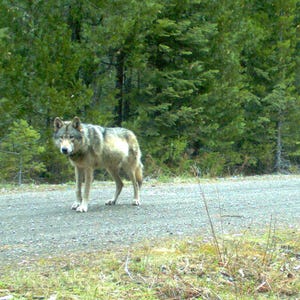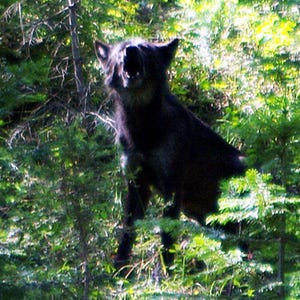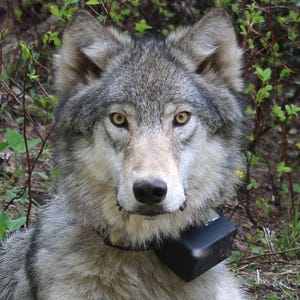When the wolf OR-7 took a historic trek into Western Oregon in 2011, he stayed on his best behavior.
The first known wolf to reach the Cascade Range since canis lupus were exterminated in the 1940s, OR-7 roamed thousands of miles, crossed the California border and eventually settled in Southern Oregon with a mate, raised pups and became head of the Rogue Pack.
In all that time, OR-7 stayed far from humans and hasn’t attacked livestock, becoming the perfect ambassador for wolves as they reclaim historic territory in Oregon’s populous west side.
Five years later, OR-33, another young and roaming wolf, hasn’t been quite so delicate.
The 2-year-old wolf roamed almost within Ashland city limits — a city of more than 20,000 — during recent weeks. He’s been seen by multiple residents, and his photo was captured by a hunter’s trail camera near Emigrant Reservoir, about 6 miles southeast of Ashland.
From June 10-12, OR-33 killed two goats and one lamb at a small livestock operation 1 to 2 miles northeast of Ashland, according to the U.S. Fish and Wildlife Service.
“This is probably the closest to a city that we’ve had a livestock depredation, and it is unusual,” UFWS wolf coordinator John Stephenson said. “I’m not sure exactly where city limits (for Ashland) are, but he was darn close.”
Stephenson said OR-33, who is wearing a radio-collar, headed east and is now more than 20 miles away from Ashland. But his appearance and actions have been more than enough to catch the attention of the environmentally conscious and tourist-friendly town.
“With OR-7, almost nobody has seen him, and he’s stayed a long way from humans,” said Greg Roberts, a media personality in Southern Oregon and owner of RogueWeather.com. “This wolf is acting more like David Lee Roth. I’ve had eight people in Ashland say that they’ve seen him around their property.
“And it’s not like we’re talking about a rural mountain town like Prospect or Butte Falls. Ashland is a large town.”
OR-33 dispersed from northeast Oregon's Imnaha Pack, the same pack as OR-7, and followed a path through the Columbia River Gorge, past Bend and La Pine, through the Ochoco Mountains and past Fort Rock State Park before stopping in Klamath County in February.The first known wolf to reach the Cascade Range since canis lupus were exterminated in the 1940s, OR-7 roamed thousands of miles, crossed the California border and eventually settled in Southern Oregon with a mate, raised pups and became head of the Rogue Pack.
In all that time, OR-7 stayed far from humans and hasn’t attacked livestock, becoming the perfect ambassador for wolves as they reclaim historic territory in Oregon’s populous west side.
Five years later, OR-33, another young and roaming wolf, hasn’t been quite so delicate.
The 2-year-old wolf roamed almost within Ashland city limits — a city of more than 20,000 — during recent weeks. He’s been seen by multiple residents, and his photo was captured by a hunter’s trail camera near Emigrant Reservoir, about 6 miles southeast of Ashland.
From June 10-12, OR-33 killed two goats and one lamb at a small livestock operation 1 to 2 miles northeast of Ashland, according to the U.S. Fish and Wildlife Service.
“This is probably the closest to a city that we’ve had a livestock depredation, and it is unusual,” UFWS wolf coordinator John Stephenson said. “I’m not sure exactly where city limits (for Ashland) are, but he was darn close.”
Stephenson said OR-33, who is wearing a radio-collar, headed east and is now more than 20 miles away from Ashland. But his appearance and actions have been more than enough to catch the attention of the environmentally conscious and tourist-friendly town.
“With OR-7, almost nobody has seen him, and he’s stayed a long way from humans,” said Greg Roberts, a media personality in Southern Oregon and owner of RogueWeather.com. “This wolf is acting more like David Lee Roth. I’ve had eight people in Ashland say that they’ve seen him around their property.
“And it’s not like we’re talking about a rural mountain town like Prospect or Butte Falls. Ashland is a large town.”
Stephenson said he expected OR-33 to move on from the Ashland area as well. On June 21, Stephenson was busy installing flashing lights, electric wire and fladry fencing around the livestock operation that was recently attacked, in an effort to discourage future incidents.
“We feel pretty confident he won’t stay here,” Stephenson said. “He’s traveled a long way — he came pretty close to Bend and La Pine and has moved on. Wolves typically avoid humans and cities.”
Wolves are protected by the federal Endangered Species Act. Nonlethal deterrence measures, like the fencing, are required following depredation. If OR-33 did become a consistent problem, there are steps Fish and Wildlife could take, Stephenson said, but he didn’t elaborate on what that could mean.
Killing a wolf in Western Oregon is illegal and punishable by a fine up to $100,000, one year in jail or both.
Joseph Vaile, executive director of the Ashland-based Klamath-Siskiyou Wildlands Center, said people in Southern Oregon shouldn’t be fearful of wolves. “It is surprising to see how close to Ashland he got, but he has since moved along, which is a good sign,” Vaile said. “Luckily, wolves are not a real threat to people.
“It's unfortunate when anyone loses livestock to wildlife, and there is more work to be done to safeguard livestock as wolves move back to rural areas in the West Coast.”
"OR-33 is not out there roaming the streets of Ashland," Stephenson said, "and he's very unlikely to. There's no threat out there."
Zach Urness has been an outdoors writer, photographer and videographer in Oregon for eight years. He is the author of the book “Hiking Southern Oregon” and can be reached at zurness@StatesmanJournal.com or (503) 399-6801. Find him on Zach Urness or @ZachsORoutdoors on Twitter.
source






No comments:
Post a Comment